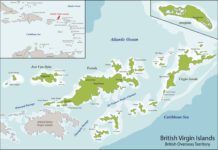Charles Nethersole has been a professional sailor for decades, and in addition to racing commitments and deliveries, hes accrued 14 years of sea time as a professional captain aboard 55- and 57-foot, Chris White designed, Atlantic catamarans.
Hes seen a wide range of conditions, but on November 16, 2016 he and two shipmates found themselves in the grip of something very different. In what seemed to be the span of seconds, the crew aboard the 57-foot Atlantic catamaran Leopard heard a freight-train-like sound, the windward hull lifted and continued to rotate-abruptly inverting everything.
PS technical editor Ralph Naranjo met Nethersole at this years Safety at Sea Seminar held at the Charleston Yacht Club in South Carolina earlier this year. The night before the event, he gave Naranjo a vivid rundown on just what happened aboard Leopard, which was 400 miles north of the Dominican Republic when the capsize occurred. During Naranjo’s seminar, Nethersole took the stage and described the capsize, which is recounted on Charles Doane’s blog.
Nethersole said crew had been monitoring a low pressure system well to the north, tracking its cold front. It was about 7 p.m.. The sun had set. The boat was heading about 150 degrees, making about seven knots. He noted that the veering breeze that had been varying in intensity form the high teens to the upper twenties.
The crew had tucked two reefs into the main and the staysail was roller-reefed to its second reef position. The autopilot was steering efficiently and Nethersole had just bared off slightly, retrimmed the main and twisted off the top of the sail to spill more breeze, to ease the motion for the cook who was preparing dinner below.
The cause of the capsize has been debated by meteorologists and bar-bound sailors alike. Some suggest that a volatile tornadic waterspout overwhelmed the vessel while others blame a microburst associated with an outflow boundary from the front.
In either case, it likely took about 70 knots of wind to defeat the cats righting moment and small amount of sail set. What was clear is that Nethersole and crew had been sailing proficiently prior to the capsize and even more importantly, they did the right things in response to the disaster. Six months, later the inverted hull of Leopard was recovered of Beaufort, NC.
The actions of Leopards crew included, roughly in order:
1. Gather essential signaling and survival gear
2. Exit the inverted hull
3. Initiate a 406 EPIRB distress signal
4. Don dry suits or survival suit
5. Secure the inflatable dinghy between upturned hulls
6. Keep valise life raft undeployed in dinghy, but at the ready
7. USCG C-130 spotted the upturned cat and rerouted the M/V Aloe to rescue (10 hours to rescue)
8. Scale the merchant ships high freeboard (not easy)





































